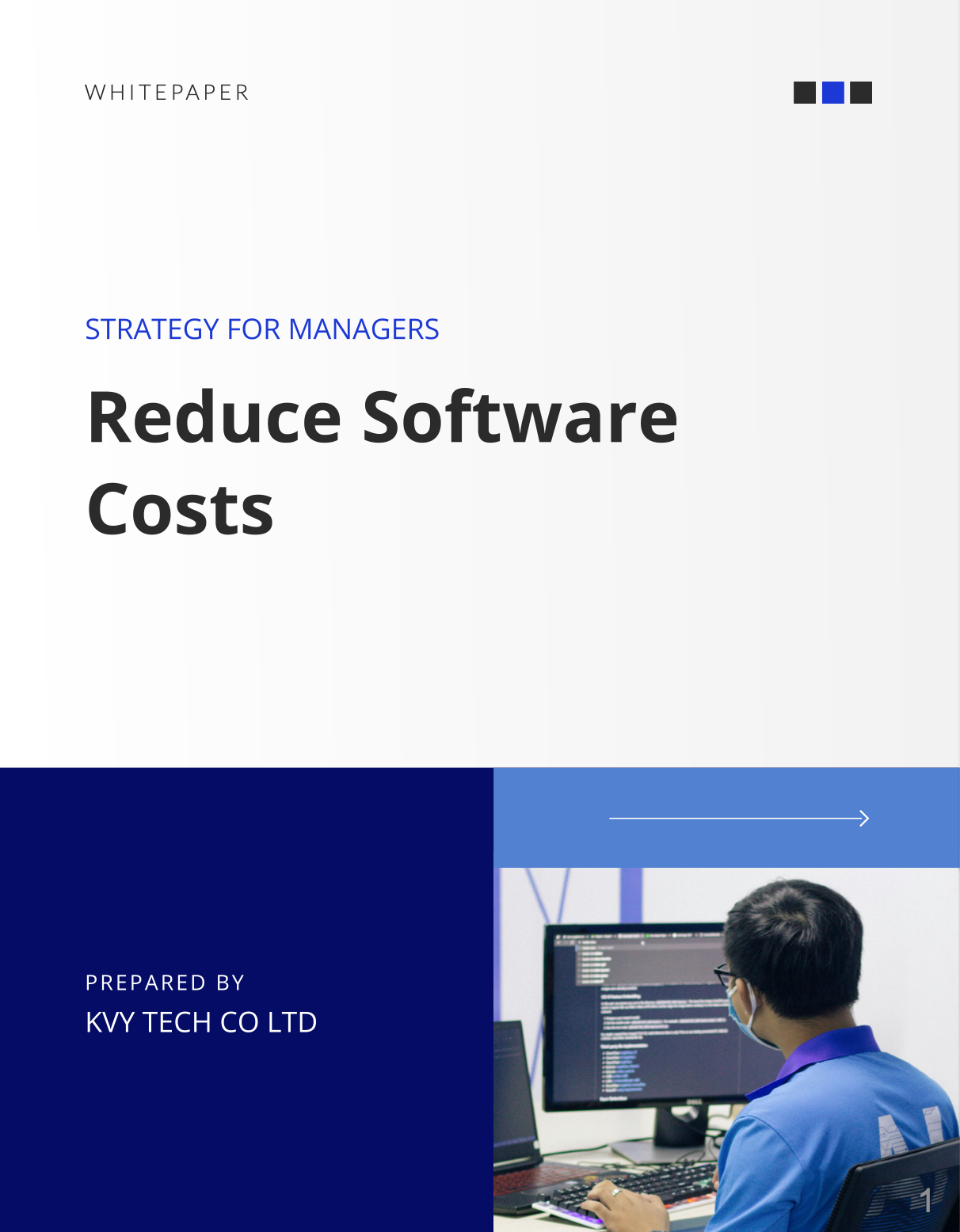
1. Introduction
1.1. Importance of Calculating Software Development Costs
It assists in resource allocation, risk identification, and setting clear expectations for stakeholders and clients.
Accurate Software Development cost estimation aids in maintaining the project scope and building trust with clients.
Miscalculations can lead to financial difficulties, delivery delays, or project termination.
Project size, type, team size, and used technologies are some factors that can influence the overall Software development cost.
Professional consultation is available to provide guidance and streamline the estimation process.
Remember, quality software development is an investment that can enhance your business’s competitive edge.
In the software industry, “Quality is remembered long after the price is forgotten.”

1.2. What to expect in this Guide?
Unlock the enigmas of software development costs, right here. This guide aims to lesson you on:
- Process of establishing software development budgets and the factors influencing them.
- Unravel the complexities surrounding the scope of work, project development, quality checks, and delivery.
- A peek into the influence of your project specifics, chosen technology, team size, and hidden costs.
- Pros and cons of different sourcing models including in-house experts, freelancers, outsourcing, and hybrid models- a key financial component of your project.
- An in-depth understanding of the estimation process, best practices, models, and smart cost assessment strategies.
Packed with handy answers to Frequently Asked Questions, let our guide equip you with a roadmap to accurately forecast software development costs and simplify your decision process.
Ready to jump aboard? Let’s help you navigate through the world of software development costs, making it less perplexing and more confidence-inspiring for you.
2. Factors Influencing Software Development Costs
- What Your Project Includes: Project specifics, scope, and complexity directly influence cost. Larger projects generally incur higher Software Development costs.
- Your Tech Ingredients: Your chosen technology stack can significantly impact software development cost. Advanced technologies require greater skillsets to implement, thereby affecting cost.
- Getting Your Infrastructure Ready: Initial setup costs such as servers, databases, development environments, and software licenses add to your project’s expense.
- The Looks and Feel: UX/UI Design: Investment in UX/UI design enhances user experience, impacting the overall Software Development cost. Think custom artwork, animations, and design aesthetics.
- The Development Approach: Your preferred development methodology, like Agile, Scrum, or Waterfall, influences cost. Agile may raise labor costs due to frequency of meetings but often results in a better-quality product.
- Checking Everything: Testing: Regular software testing, though time consuming and costly, is essential to correct errors before software launch.
- Safeguarding Your Project: Security: Security measures such as encryption, multi-factor authentication, and regular audits, necessary to protect against threats, significantly affect cost.
- Future-Proofing: Updates and Maintenance: Ongoing costs for updates and maintenance post software deployment contribute to the overall software development project expense.
| Factors | Approximate % Impact on Cost |
|---|---|
| Development Complexity | 50-60% |
| Technologies Used | 10-20% |
| Developer Expertise | 15-30% |
| Project Time Frame | 5-15% |
| Maintenance and Support | 20-30% |
| Location of Development Team | 10-25% |
3. Key Cost Components of Software Development Projects
3.1. Scoping Out the Work
- The scoping stage focuses on defining the project’s needs and establishing an initial plan.
- Scoping deliverables include a clickable prototype, application schema, and software development cost breakdown.
- Good scoping enhances the accuracy of estimates and steers the project towards success.

3.2. The Nitty-Gritty of Development
- The development phase involves the actual constructing of the software.
- Costs in this phase are influenced by requirements, project scope, technology stack, development methodology, and team size and experience.
- An efficient software development team typically includes a project manager, developers, and QA testers.
3.3. Quality Checks: Testing and Assurance
- Software testing ensures the product works as expected and is bug-free.
- While thorough testing can add to the costs, it prevents expensive fixes down the line by detecting and fixing issues early.
- QA testers play a vital role in this process, evaluating functionality and validating system performance against predefined requirements.

3.4. Wrapping Up and Ongoing Work: Delivery and Maintenance
- Post-development, the software needs to be delivered – this could involve deployment on servers or app stores.
- The software will require ongoing maintenance and support, factors which constitute part of the long-term costs.
- Maintenance includes updates for compatibility with evolving tech, security patches, and improvements based on user feedback.
| Factor | Description | Estimated Impact on Cost |
|---|---|---|
| Deployment | Process of delivery of a web or mobile app to the relevant servers or stores. | 5 – 7% of total project cost |
| Software Maintenance | Includes updates for compatibility with technical advancements, application of security patches, and upgrades based on user feedback. | 15 – 20% of total project cost per year |
| Support and Upgrades | The continuous process to address user issues, provide necessary training, and implement improvements. | 5 – 10% of total project cost per year |
4. Key Software Development Cost Factors
4.1. Understanding Your Project
- The type, size, and scope of your project can greatly influence the software development cost.
- The technology stack used and the methodology employed also impact the final estimation.
- Larger and more complex projects usually require more resources and time, increasing the Software development costs

4.2. The Impact of Chosen Technology
- Your technology stack can significantly affect your expenditure.
- Advanced technologies may be expensive but provide smoother development and superior results.
- Older technology might save costs initially but could lead to higher maintenance and support expenses later.
4.3. The Implications of Your Team Size
- Each member of your development team contributes to a part of the software development project cost.
- A larger team may speed up the development process but will inevitably increase costs.
- A smaller team could reduce personnel expenses, but could prolong the timeline and increase project duration costs.
4.4. Hidden Costs to Consider
- Remember to account for hidden Software development costs such as ongoing support and maintenance post-launch, the team’s location, and unexpected delays that require extra resources.
- It is advisable to have a contingency budget for unexpected expenses and setbacks.
| Factor | Estimated Cost Impact |
|---|---|
| Ongoing Support and Maintenance Post-Launch | Can increase overall project costs by 15-20% |
| Location of the Team | A team located in a high-cost country can be 2-3 times more expensive than a team from a lower-cost country |
| Unexpected Delays/Extra Resources | Can hike the project costs up by 25-30% depending on the severity of the delay |
| Contingency Budget | Recommended to reserve 10-15% of the overall project budget |
5. Sourcing Models for Software Development Projects
5.1. In-house Experts
- High degree of control over projects.
- Deep understanding of company culture and goals.
- However, assembling and maintaining a team can be expensive.

5.2. Freelancers
- Deliver specialized skills for short-term tasks.
- Provide software development cost advantages and flexibility.
- Challenges: commitment issues, accountability, time zone, and language barriers.
5.3. Outsourcing
- Effective for projects requiring specialized skills.
- Cost-effective, especially in regions with lower labor costs.
- Challenges: language barriers and time zone differences.
5.4. Hybrid Models
- Combination of in-house staff, freelancers, and outsourcing.
- Provides a balance of control, cost-effectiveness, and flexibility.
- Key: assigning appropriate parts of the project to each type of resource.
| Factor | Cost Influence |
|---|---|
| In-House Staff | This generally incurs the highest costs due to regular salaries, benefits, and overhead expenses. However, it enables you to maintain the most control and direct feedback. Depending on the size and complexity of the project, this could increase costs by up to 50-70%. |
| Freelancers | Freelancers usually work on a contract basis, so their costs can vary depending on their experience, skills, and the length of the contract. The use of freelancers can reduce labor costs by around 20-30%. |
| Outsourcing | Outsourcing to a location with lower labor costs can significantly reduce your project expenses. However, the reduction in direct control may mean additional costs in terms of monitoring, communication, and quality control. Outsourcing could potentially save anywhere between 30-60% of the costs. |
| Project Size and Complexity | Larger and more complex projects typically require more resources and longer development time, thus raising costs. Depending upon the project’s scope, this could raise development costs by 40-70%. |
| Technology Used | The technology stack required for project implementation directly influences the cost, as some technologies require specialized, and thus more expensive, talent. Technology choice could affect costs by 10-20%. |

6. Estimation Process and Best Practices
Step 1: Size of the Development Team
- Smaller teams may take more time but can be cost-effective for smaller projects.
- Larger teams may be efficient for substantial projects but can also increase the cost.

Step 2: Project Complexity
- More complex projects demand more resources, increasing the cost.
- Factors adding to complexity include custom functionalities, integration with existing systems, and industry-specific regulations.
Step 3: Type of Software Project
- The kind of software being developed can significantly influence the cost.
- Simple web applications can be relatively cheaper, while complex enterprise software or advanced mobile apps can be more costly.
Step 4: Technological Stack
- The chosen technology stack is a considerable cost factor.
- Standard, commonly used technology stacks are often more affordable.
- Specialized, cutting-edge technologies can demand premium resources and thereby raise costs.
Step 5: Time Frame
- Fast turn-around times can mean more team members working simultaneously, increasing costs.
- Longer timelines can allow for smaller, sometimes more cost-efficient teams, although delivery could be slower.
Step 6: Support and Maintenance
- Post-development support and maintenance costs are often overlooked but should be included in the total cost.
- Updates, bug fixes, and regular maintenance are integral to a software’s lifecycle and subsequently its total cost of ownership.
| Factor | Scale of Impact* | Estimated Cost Impact** |
|---|---|---|
| Software Complexity | High | +20% to +50% |
| Technologies Used | Moderate | +10% to +25% |
| Development Team | High | +15% to +40% |
| Project Timeline | Moderate | +10% to +30% |
| Support & Maintenance | High | +20% to +60% |
| Team Location | Variable | -10% to +20% |
* ‘Scale of Impact’ refers to the potential range by which the cost might increase due to the specified factor.
** ‘Estimated Cost Impact’ indicates the estimated increase/decrease range in percentage terms that could be expected from each factor’s variation. The actual impact will vary depending on the specific conditions of every project.
7. Estimation Models
7.1. Basic Estimation (Rough Estimation)
- A broad overview of your project costs
- A useful precursor to comprehensive estimations
- A necessary step in determining project budget feasibility

7.2. Detailed Breakdown (Detailed Estimation)
- A thorough breakdown of every project component
- Factors include project scope, technology stack, development methodology, team size, team experience, and location
- A comprehensive cost analysis that leaves no room for unforeseen expenses
7.3. Types of Collaboration: Engagement Models
- Three main methods: parametric cost estimation, analogous cost estimation, and bottom-up cost estimation
- Choosing the right model based on project complexity and size is crucial
- The suited engagement model can lead to cost savings and project success
| Estimation Method | Factors | Cost Implication |
|---|---|---|
| Parametric Cost Estimation | Project Size, Complexity, Number of Developers, Project Duration | Cost tends to increase with project size, complexity and the number of developers involved. Longer project duration also implies higher cost due to overheads and resources involved. |
| Bottom-Up Cost Estimation | Task Complexity, Required Skills, Manhours Required | With this method, cost increases with task complexity, the intricacy of skills required and the manhours. Complex tasks require more skilled developers hence driving costs up. |
| Analogous Cost Estimation | Previous Project Data, Similarity index | This method draws from previous projects. Higher costs are likely if past projects had overruns or if the current project differs significantly from past ones, causing a large variability in cost. |
Above all, remember to refine your estimates during the initial phases of software development, make use of best practices, and consider all key project factors. Your budget will thank you for it.
8. Conclusion
8.1. Main Highlights
- Estimating the cost of software development is a multifaceted task that is crucial to the success of project management.
- Aspects such as initial set-up, revisions, testing phases, debugging, deployment, and ongoing costs like maintenance and support should all be factored into the cost estimate.
- A meticulous estimation process is vital for managing stakeholders’ expectations, identifying potential costs, risks, and opportunities, and ensuring appropriate resource allocation. Consulting a software development company can aid in this effort.
8.2. The Importance of getting your numbers right
- Accuracy in cost estimation is key; a miscalculation can significantly impact the project’s success and undermine business objectives.
- An overestimate may divert funds from necessary areas, while an underestimate could lead to financial strain, delays, or project cancellation.
- Investing time in accurate initial estimates and consistent cost monitoring throughout the project is crucial. The support of a Business Analyst can be valuable for overseeing different cost factors and guiding the project towards its goals.
9. Frequently Asked Questions (FAQ)
We can estimate the cost of software development by considering many factors such as the size and complexity of the project, the technology used, the size of the development team, the project timeline, and the ongoing maintenance costs.
The chosen technology can greatly impact the overall software development cost. Some technologies may require more specialized or experienced developers, who typically charge more for their services. Others may demand more testing or have a higher licensing cost.
It depends on various factors such as project specifics, your existing team’s expertise and capacity, and outsourcing rates. It’s important to consider all aspects before making a decision.
More complex projects usually require a larger team and more time to complete, increasing the cost. Project complexity can also necessitate the use of more advanced technologies or tools, which can further inflate the budget.
Quality Assurance is a critical part of any software development project. The extent to which you need dedicated QA testers would depend on factors like the size and complexity of your project.
These platforms often provide templates and tools that can save development time and resources. However, if you require custom features or extensive customization then the costs can go up.
Developing an AI-based system usually demands more advanced skills and a higher development budget. However, in the long run, AI may help to reduce manpower costs and improve productivity.
Start with thorough research and planning. Get a clear understanding of your needs and consult with your development team or other industry experts. You should also be ready to adjust your estimates as the project progresses and you gather more information.


